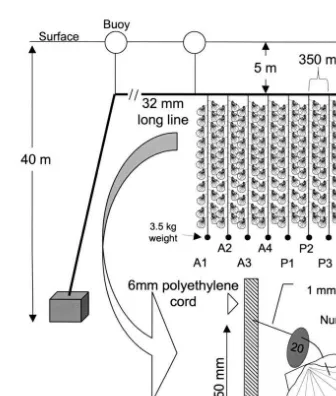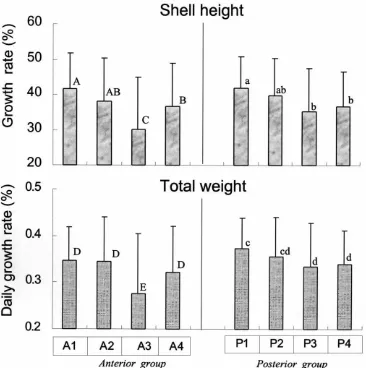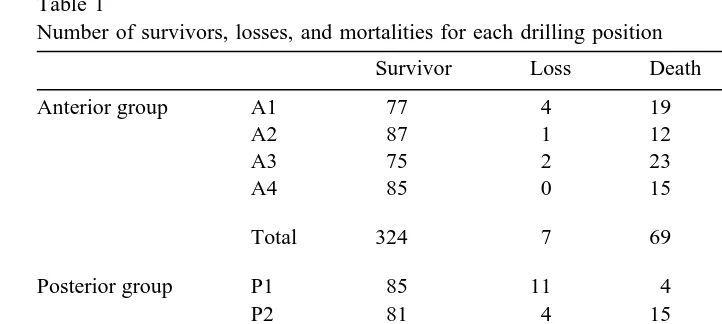www.elsevier.nlrlocateraqua-online
Drilling position of the ear affects growth and
ž
/
mortality of scallop Patinopecten yessoensis, Jay
in ear-hanging culture
Takeshi Hamada
a,), Nariharu Yamashita
b,1,
Tomohiko Watanabe
c,2, Shunji Natsume
d,3a
Institute of Fisheries Management Technology, Sankaido Building 9F, 9-13 Akasaka 1, Minato, Tokyo 107-0052, Japan
b
Faculty of Fisheries, Hokkaido UniÕersity, Minato 3-1-1 Hakodate Hokkaido, 041-8611, Japan
c
Nemuro-Hokubu Fisheries Extension Office, Shibestu, Hokkaido, 086-1634, Japan
d
The Hokkaido UniÕersity Forests, Faculty of Agriculture, Hokkaido UniÕersity. Kita-9jyo, Nishi-9chyome,
Sapporo, 060-0809, Japan
Received 24 February 2000; received in revised form 12 July 2000; accepted 28 July 2000
Abstract
We evaluated the effect of where the hole is drilled in the shell when using the ear-hanging or
Nimai-ake method in scallop aquaculture. We examined its influence on growth and mortality
during 8-month growth trials on the scallop Patinopecten yessoensis at Shikabe, Japan. Our
Ž .
observations showed: 1 no differences in growth and mortality between drilling the hole in the
Ž .
posterior compared to the anterior ear; 2 that drilling at positions next to the ligament causes
Ž .
increased mortality; 3 that the lowest increase in shell height and total weight is obtained when
Ž .
the hole is drilled next to the ligament on the anterior ear; and 4 that growth is greatest when the
Ž .
hole is drilled near the corners of the ears either on the anterior or posterior ears . q2001 Elsevier Science B.V. All rights reserved.
Keywords: Patinopecten yessoensis; Ear hanging culture; Drilling position; Growth rate
)Corresponding author. Tel.:q81-3-3584-7639; fax:q81-3-3582-4770.
Ž . Ž .
E-mail addresses: [email protected] T. Hamada , [email protected] N. Yamashita .
1
Tel.:q81-138-40-8851; fax:q81-138-40-8851.
2
Tel.:q81-1538-2-3738.
3
Tel.:q81-11-706-2589.
0044-8486r01r$ - see front matterq2001 Elsevier Science B.V. All rights reserved. Ž .
Several studies have examined the influence of various factors on the growth of sea
Ž
scallops in suspended net culture Jeff and Reinsnes, 1985; Parsons and Dadswell, 1992;
.
Cote et al., 1993; Claereboudt et al., 1994 . However, no studies have evaluated factors
ˆ ´
affecting the growth of scallops in the ear-hanging method. This paper describes an assessment of the ear-hanging culture method.
In Japan, aquaculture of the scallop Patinopecten yessoensis follows laver and oyster aquaculture in yield. Annual yield of cultured scallop was less than 100 000 tons until 1985, but has been more than 200 000 tons since 1992. Use of the ear-hanging culture
Ž .
method has contributed to this increase Miyazawa et al., 1994 .
Ear-hanging culture is used after the ‘intermediate culture stage’ in which juvenile scallops are reared in pearl nets from summer until the next spring. In ear-hanging culture, a hole is made through the ear of 55–80 mm shell height scallops with a drill.
Ž .
Two general methods are used Ito, 1991 : drilling a hole near the byssal notch in the
Ž .
left anterior ear, called Itimai-ake method in Japan and drilling a hole through both
Ž .
right and left anterior ears called the Nimai-ake method .
Many scallop farmers use the Itimai-ake method as it appears to cause less damage
ŽChawanya, 1992 . Nevertheless, most scallop farmers in Shikabe, Hokkaido, outside.
Funka bay, Hokkaido, use the Nimai-ake method, as it results is fewer scallops being shaken off the lines by the strong wave action of the open sea.
Previously, we showed that using the Nimai-ake method caused mechanical injury
Žpuncture or laceration to the scallop mantle that differed when the hole was drilled in.
Ž .
the anterior or posterior ear Hamada et al., 1999 . In this paper, we further examine the effect of drilling position when using the Nimai-ake method on the growth and mortality of scallops at Shikabe.
2. Materials and methods
2.1. Experimental design and measurements
Ž .
We examined the effects of four drilling positions on the anterior A and posterior
Ž .P valves: i 2.5 cm from the hinge near the corners of the ears A-1 and P-1 ; ii atŽ . Ž . Ž .
Ž . Ž .
the middle point of the hinge line and 2.5 cm down A-2 and P-2 ; iii near the outer
Ž . Ž .
edge of the ligament and 2.5 cm down; iv in the center of the ears A-4 and P-4
ŽFig. 1 ..
We began our study on 28 June 1998, by suspending two strings of 100 scallops for each of the above four drilling positions from a long line at 5 m in depth at Shikabe. Each scallop, identified with a numbered tag, was hung with artificial catgut at 15 cm
Ž .
distances along the vertical ropes Fig. 2 . The scallops were 1-year-old individuals of measured shell height and total mass. They had been bred from individuals collected
Ž
Fig. 1. Schematic diagram of the eight drilling positions.
.
middle of the period when scallops are harvested commercially at Shikabe , after 237 days at sea, we collected the scallops and scraped fouling organisms from the shells.
Ž
Then we determined the numbers of mortalities, survivors and lost scallops which had
.
Fig. 2. Experimental arrangement.
2.2. EÕaluation of growth and mortality
Ž .
Growth rate of shell height HGR was calculated as follows
l2yl1
HGRs =100 %
Ž .
l1
Ž .
In addition, the daily growth rate of total weight WGR was calculated as follows
W2yW1
WGRs =100 % .
Ž .
W1qW2
n
ž
/
2
Where W and W are the scallop total mass at 28 July 1998 and at 20 February 1999,1 2
Ž .
respectively; n is the number of days s237 days .
Ž .
The mortality rate MR was estimated by
M
MRs =100 %
Ž .
SqM
where S and M are the number of surviving and the dead scallops, respectively.
2.3. Statistical analysis
Differences in HGR data and WGR data between the anterior and posterior group were tested using Wilcoxcon’s sum rank test. One-way ANOVA was used to test the differences in HGR data and WGR data among the drilling positions of the anterior and posterior groups. If the mean HGR and mean WGR were significantly different, Scheffe’s multiple comparison was used. HGR data and WGR data were exp x-trans-formed to obtain uniform variance. Differences in MR data among each drilling position were tested using chi-square test.
3. Results
3.1. Growth
The mean growth rates in shell height and total weight of the anterior and posterior drilled groups were 36.8% and 38.5%, 0.32% and 0.35% , respectively. The Wilcoxcon’s sum rank test showed no differences in shell growth between the anterior and posterior
Ž .
groups Ps0.11 , but weight growth in the posterior group was greater than the
Ž .
anterior group P-0.001 .
The shell and weight growth of each drilling position are shown in Fig. 3. A3 was lower in shell and weight growth than any other drilling position in the anterior group
ŽP-0.05 . A1 was greater in shell growth than any other drilling positions in the.
Ž .
anterior group P-0.05 . P1 was greater in shell and weight growth than any other
Ž .
drilling position in the posterior group P-0.01 .
3.2. Mortality rate
()
T.
Hamada
et
al.
r
Aquaculture
193
2001
249
–
256
Fig. 3. Comparison of the mean HGR and WGR among the eight drilling positions. The error bars are the standard deviation. The bars sharing the same latter are not
Ž .
Table 1
Number of survivors, losses, and mortalities for each drilling position
Ž .
Survivor Loss Death Mortality rate %
a)
Anterior group A1 77 4 19 15.6
a
Posterior group P1 85 11 4 4.5
a
Total 321 17 62 16.2
x
Mean 80.6 3 16.4 16.9
) Ž .
Values followed by the same superscript are not significantly different P)0.05 .
Ž .
and posterior group Ps0.97 . A3 and P3 were highest, and P1 was lowest in mortality. However, if losses were regarded as mortality, differences in mortality rates
Ž .
among the eight drilling positions were not significant Ps0.11 . 4. Discussion
Almost no scallop farmer drills the posterior ear. The handbook of scallop farming
Ž
states that drilling in the posterior ear causes immaturity and high mortality Ito, 1976;
.
Chawanya, 1992 . However, our experiments showed that growth and survival were similar for scallops drilled in the posterior and anterior ears. We believe this has not been reported before.
The shell and weight growth of A3 were lowest in the anterior group. Moreover, the mortality rates of A3 and P3 were higher than scallops with other drilling positions. These results suggest that drilling at positions next to the ligament is not a good method. This may be attributed to factors that prevent growth of scallops. For example, the mantle may be injured, not only by drilling at A3 and P3, but also by passing an artificial catgut through their hole. The mid-gut gland may also be damaged. Scallops
Ž
drilled at these two drilling positions only received lacerations of the mantle Hamada et
.
al., 1999 . The shell growth of A1 was the greatest of the anterior group. The shell and weight growths of P1 were the greatest, and the mortality rate of P1 was the lowest in the posterior group. The scallops drilled at A1 and P1 probably received only a slight injury or were uninjured, and artificial catgut passed through the holes could not damage the mantle nor prevent the expansion of the mantle.
In conclusion, this study suggests that scallop farmers do not have to avoid drilling in
Ž
the posterior ear, but have to avoid drilling at positions near the ligament such as at A3
. Ž .
We should like to express our grateful thanks to Mr. Chikara Kimura and Mr.
Ž .
Takeshi Tsukiji Shikabe Fisheries Cooperative Association who extended their kind
Ž
assistance. If it were not for Mr. Daichi Mimura and Mr. Shunsuke Takagi University
.
student, Faculty of Fisheries, Hokkaido University , this paper would not be completed. This study was supported in part by a Research Fellowship of Japan Society for the Promotion of Science for Young Scientist
References
Ž .
Chawanya, H., 1992. Handbook for Scallop Industry, Japanese title: Hotategai Toriatukai No Tebiki .
Ž .
Hokkaisuisanshinbun Press, Sapporo, pp. 45–56 in Japanese .
Claereboudt, M.R., Bureau, D., Cote, J., Himmelman, J.H., 1994. Fouling development and its effect on theˆ ´
Ž .
growth of juvenile giant scallops Placopecten magellanicus in suspended culture. Aquaculture 121,
327–342.
Cote, J., Himmelman, J.H., Caereboudt, M., Bonardelli, J.C., 1993. Influence of density and depth on theˆ ´
Ž .
growth of juvenile sea scallops Placopecten magellanicus in suspended culture. Can. J. Fish. Aquat. Sci. 50, 1857–1869.
Ž
Hamada, T., Yamashita, N., Watanabe, T., Natsume, S., 1999. Mechanical injury of scallop Patinopecten
. Ž .
yessoensis, Jay mantle, occurring with drilling work of the ear-hanging culture. Fish. Eng. 36 2 ,
Ž .
147–152 in Japanese with English abstract .
Ž . Ž .
Ito, H., 1991. Japan Chapter 14: Fisheries and aquaculture . In: Shumway, S.E. Ed. , Scallops: Biology, Ecology and Aquaculture. Elsevier, Amsterdam, pp. 1017–1047.
Ž . Ž
Ito, S., 1976. Techniques of scallop farming. In: Imai, T. Ed. , Aquaculture in Japan Japanese title: Senkai
. Ž .
Kanzen Yoshoku Kouseishakouseikaku, Tokyo. pp. 216–222 in Japanese .
Jeff, C.W., Reinsnes, T.G., 1985. The significance of various environmental parameters for growth of the
Ž .
Iceland scallop, Chlamays islandica Pectindae , in hanging culture. Aquaculture 44, 229–242.
Miyazawa, H., Sano, M., Miki, K., 1994. The reorganization of the structure of scallop aquaculture in 1980. J.
Ž .
Nth. Jpn. Fish. Econ. 22, 13–26 in Japanese with English title .
Parsons, R.E., Dadswell, M.J., 1992. Effect of stoking density on growth, production, and survival of the giant
Ž .



